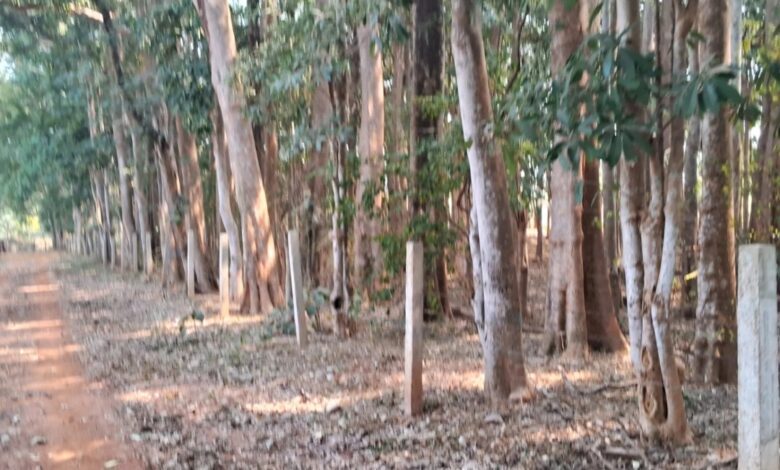Social forestry an important tool for modern Conservation Biology initiatives


Saikat Kumar Basu
Social forestry is important for the conservation of forests because it involves active participation and involvement of local communities in forest management. Here’s why it’s significant:
A. Community involvement: Social forestry empowers local communities to actively participate in forest conservation efforts. When people feel a sense of ownership and responsibility towards forests, they are more likely to protect and sustainably manage them.
B. Biodiversity conservation: By engaging local communities in tree planting, afforestation, and reforestation activities, social forestry initiatives contribute to the preservation of biodiversity within forests. This helps maintain ecosystem balance and supports various plant and animal species.
C. Economic benefits: Social forestry projects often provide economic incentives to local communities through activities such as sustainable harvesting of forest products, ecotourism, and carbon credit trading. This can reduce reliance on unsustainable practices like illegal logging and land conversion for agriculture.
D. Carbon sequestration: Forests play a crucial role in absorbing carbon dioxide from the atmosphere, thereby mitigating climate change. Social forestry activities, such as afforestation and reforestation, enhance carbon sequestration, helping to combat global warming.
E. Soil and water conservation: Trees planted through social forestry programs help prevent soil erosion, regulate water flow, and maintain water quality. This is essential for ensuring the long-term health and productivity of forests and surrounding ecosystems.
Overall, social forestry fosters a holistic approach to forest conservation by integrating environmental, social, and economic objectives, thereby promoting sustainable development and the long-term well-being of both forests and communities.
Role of social forestry in transforming rural economy
Social forestry can contribute to economic development in several ways. By involving local communities in tree planting and management, it can provide employment opportunities, generate income through the sale of timber and non-timber forest products, enhance land productivity, and contribute to environmental conservation, all of which can ultimately boost the economy of a region. Social forestry can help to transform rural economies in several ways:
A. Employment Opportunities: Social forestry projects create employment opportunities for rural communities through activities such as afforestation, nursery management, forest protection, and sustainable harvesting. This helps in reducing unemployment and poverty in rural areas.
B. Income Generation: By participating in social forestry initiatives, rural communities can generate income through the sale of forest products like timber, firewood, non-timber forest products (NTFPs), and eco-tourism activities. This additional income can improve their livelihoods and standard of living.
C. Skill Development: Social forestry projects often involve training and capacity-building programs for local residents in various aspects of forestry management, sustainable agriculture, agroforestry techniques, and eco-tourism services. These skills enhance their employability and entrepreneurial opportunities.
D. Environmental Conservation: Social forestry promotes the conservation and restoration of degraded lands, which can result in improved soil fertility, water retention, biodiversity conservation, and carbon sequestration. These environmental benefits contribute to the sustainability of rural livelihoods and ecosystems.
E. Community Empowerment: By involving local communities in decision-making processes and resource management activities, social forestry empowers them to take ownership of their natural resources. This fosters a sense of responsibility, cooperation, and self-reliance, leading to more resilient and inclusive rural tribal life.

Integration of social life with tribal life and Culture
Integrating social forestry with tribal life fosters mutually beneficial relationships between communities and their surrounding ecosystems, leading to improved livelihoods, cultural preservation, and environmental sustainability. Social forestry, when integrated with tribal life, can have several positive impacts:
A. Community Participation: Social forestry projects often involve the active participation of tribal communities in various activities such as afforestation, forest management, and conservation efforts. This engagement empowers tribal communities and strengthens their connection to the land.
B. Livelihood Support: Social forestry initiatives can provide alternative sources of income for tribal communities through activities like agroforestry, non-timber forest product collection, and eco-tourism. These activities are often aligned with the traditional knowledge and practices of the tribes, allowing them to sustain their livelihoods while conserving the environment.
C. Cultural Preservation: Social forestry programs that respect and incorporate traditional tribal knowledge and practices help preserve indigenous cultures. By recognizing the importance of tribal customs, beliefs, and traditional land management techniques, social forestry can contribute to the preservation of cultural heritage.
D. Resource Management: Integrating social forestry with tribal life can enhance the sustainable management of natural resources. Tribes often have deep knowledge of their local ecosystems, which can be leveraged to promote biodiversity conservation and sustainable utilization of forest resources.
D. Empowerment and Governance: Social forestry initiatives can facilitate the empowerment of tribal communities by involving them in decision-making processes related to forest management and conservation. This participatory approach strengthens local governance structures and promotes community-based natural resource management.
How is social forestry important for ecology and economics integrated together ?
By integrating ecology and economics, social forestry contributes to the sustainable development of communities while conserving and enhancing forest ecosystems. This integration is essential for achieving both environmental and socio-economic goals. Social forestry, which involves the management and protection of forests for the benefit of local communities, is important for both ecology and economics in several ways:

1. Ecological Importance:
A. Biodiversity Conservation: Social forestry promotes the conservation of biodiversity by preserving habitats for various species of plants and animals.
B. Soil Conservation: Trees planted in social forestry projects help prevent soil erosion, maintain soil fertility, and improve water retention.
C. Carbon Sequestration: Trees absorb carbon dioxide from the atmosphere, mitigating climate change by acting as carbon sinks.
D. Water Management: Forests play a crucial role in regulating the water cycle, contributing to groundwater recharge, regulating stream flow, and reducing the risk of floods and droughts.
2. Economic Importance:
A. Livelihoods: Social forestry provides employment opportunities for local communities through activities such as tree planting, forest management, and eco-tourism.
B. Income Generation: Communities can derive income from the sustainable harvesting of forest products such as timber, non-timber forest products (e.g., fruits, nuts, medicinal plants), and ecotourism services.
C. Resource Sustainability: By promoting sustainable forest management practices, social forestry ensures the long-term availability of forest resources for future generations.
D. Poverty Alleviation: Social forestry projects can help alleviate poverty by providing alternative sources of income and reducing dependence on unsustainable natural resource extraction.

What are the limitations of social forestry ?
Social forestry, while beneficial in many ways, also has its limitations. Addressing these limitations requires comprehensive planning, stakeholder engagement, and ongoing monitoring and evaluation to ensure the effectiveness and sustainability of social forestry initiatives.
A. Limited Scope: Social forestry initiatives often focus on specific areas or communities, limiting their overall impact on larger environmental issues.
B. Dependency: There’s a risk of creating dependency among local communities on external support for forest management, which may not be sustainable in the long term.
C. Resource Constraints: Social forestry projects may face resource constraints such as funding, expertise, and manpower, hindering their effectiveness and scalability.
D. Land Tenure Issues: In some cases, unclear land tenure rights can lead to conflicts over ownership and management of social forestry areas, undermining their success.
E. Ecological Considerations: While social forestry can contribute to reforestation efforts, the selection of tree species and planting methods must be carefully considered to ensure ecological balance and prevent unintended consequences such as invasive species or monoculture.
F. Social Equity: There may be challenges in ensuring equitable distribution of benefits among community members, particularly if certain groups have more influence or access to resources than others.
G. Policy and Governance: Inadequate policies or ineffective governance structures can impede the implementation and sustainability of social forestry projects, leading to limited impact.
What are the broader implications of the social forestry to our society
Social forestry, which involves the involvement of local communities in the management and conservation of forests, has several broader implications for society:
A. Environmental Conservation: Social forestry promotes sustainable forest management practices, leading to the conservation of biodiversity, protection of watersheds, and mitigation of climate change through carbon sequestration.
B. Livelihood Opportunities: It provides alternative livelihood options for rural communities, reducing dependency on forest resources for sustenance while creating employment opportunities through activities like agroforestry, eco-tourism, and non-timber forest product harvesting.
C. Poverty Alleviation: By empowering local communities to actively participate in forest management and benefit from forest resources, social forestry contributes to poverty alleviation and socioeconomic development in rural areas.
D. Community Empowerment: Social forestry fosters a sense of ownership and responsibility among local communities towards forest resources, empowering them to make decisions that affect their environment and well-being.
E. Conflict Resolution: Involving local communities in forest management can help mitigate conflicts between conservation goals and the needs of indigenous peoples or local residents, fostering collaboration and mutual understanding.
D. Cultural Preservation: Social forestry initiatives often incorporate indigenous knowledge and traditional practices, helping to preserve cultural heritage and strengthen the identity of indigenous communities.
E. Urban-Rural Linkages: Social forestry can bridge the gap between urban consumers and rural producers by promoting sustainable supply chains for forest products and fostering awareness about the importance of forests among urban populations.
Social forestry has the potential to contribute to sustainable development by addressing environmental, social, and economic challenges while promoting inclusive and participatory approaches to natural resource management.
Photo credit: Saikat Kumar Basu






